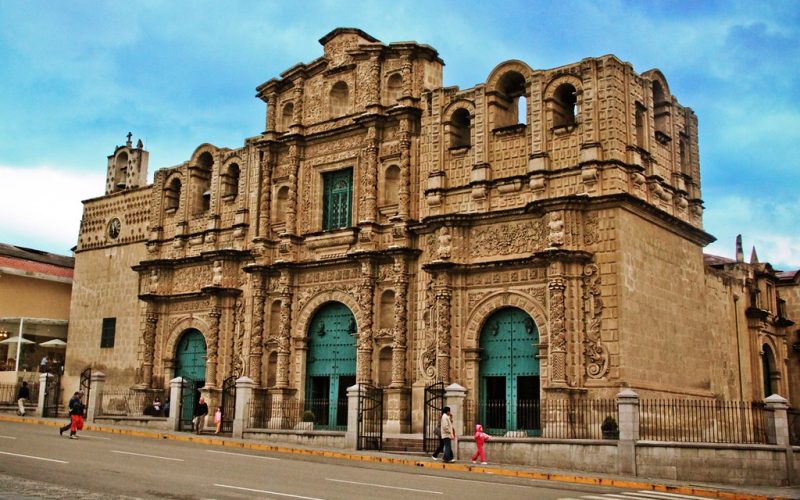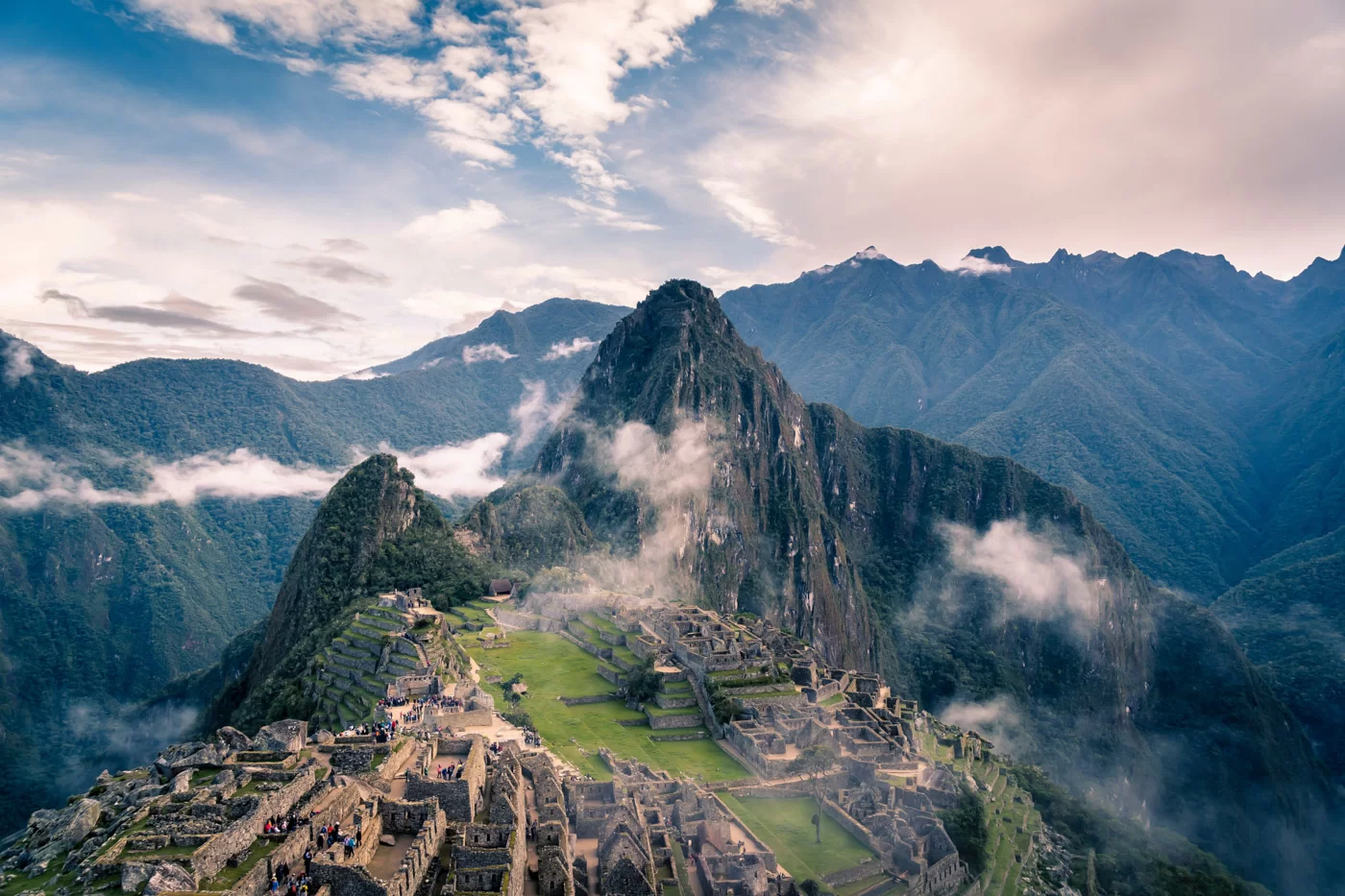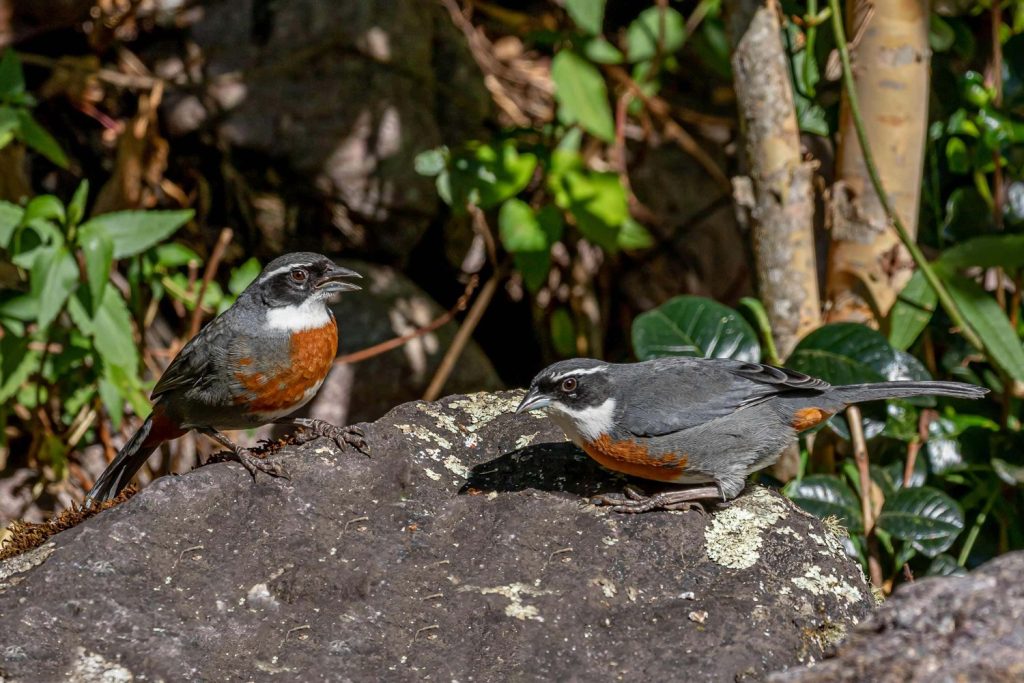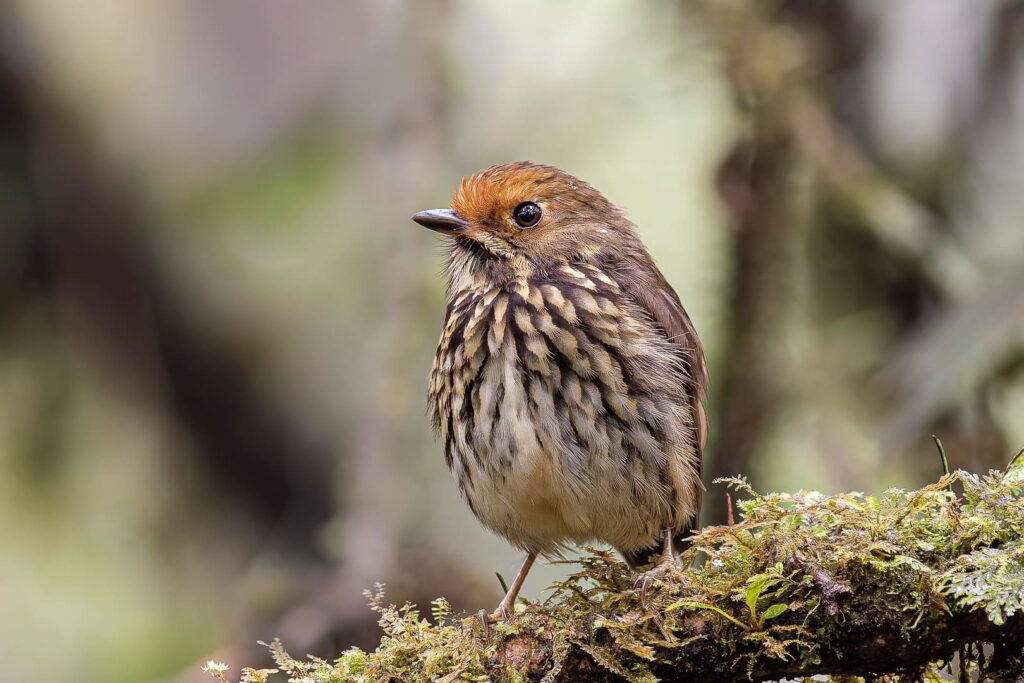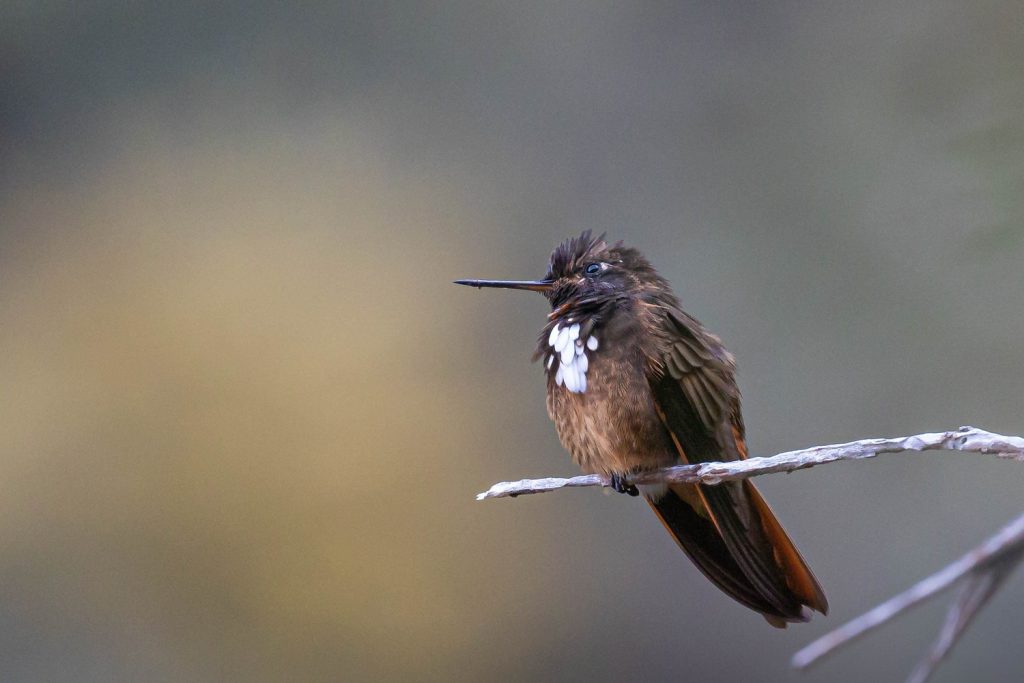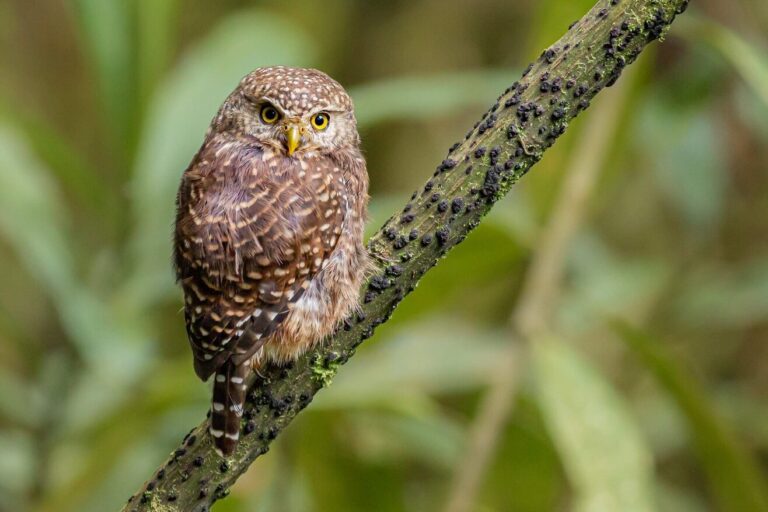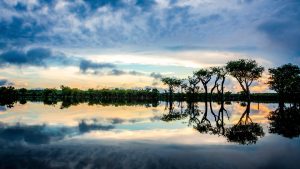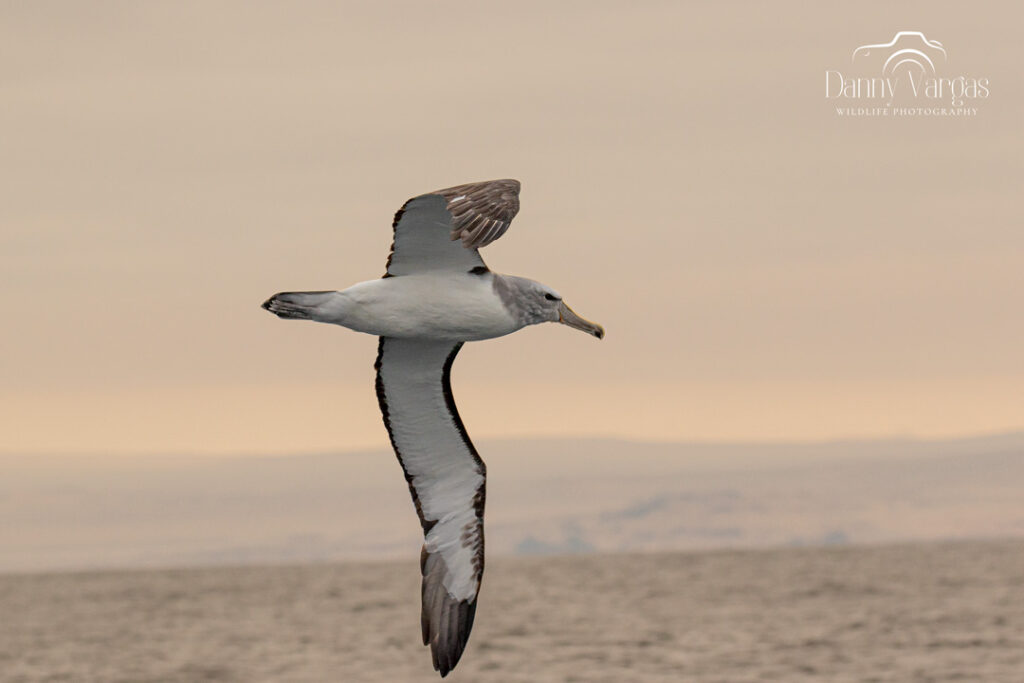BIRDING AND CULTURE AT NORTHERN PERU
- From
- Trip Type
- Activities
- Trip Duration
- Group Size
- Habitats Covered
- Trip Outline
- Itinerary
- Trip Includes
- Gallery
- FAQ
Trip Outline
NORTHERN PERU BIRDING AND CULTURE TOUR: FROM MOCHICA TOMBS TO CLOUD FOREST TREASURES
Experience the ultimate blend of archaeology, endemic-rich birding, and stunning Andean scenery on this exclusive Northern Peru Birding and Culture Tour. Over 10 immersive days, journey through ancient Moche temples, cloud forest sanctuaries, and colonial cities—each offering iconic cultural landmarks and high-value birding targets.
🏺 Culture Meets Endemism in Peru’s North
Northern Peru is a world apart. With some of the highest levels of bird endemism, it’s also a place where pre-Inca and colonial history echo in every valley. This tour was designed for birders who are also curious travelers—those who want to spot a Marvelous Spatuletail in the morning and stand before a 1,500-year-old pyramid by afternoon.
We’ll visit legendary sites like the Señor de Sipán tomb, Kuelap fortress, and the Inca Ransom Room in Cajamarca, while also exploring Tumbesian dry forest, the arid Marañón Valley, and humid Utcubamba cloud forests, home to some of Peru’s rarest and most dazzling birds.
🦜 Target Endemics and Birding Highlights
This Northern Peru birding and archaeology tour offers a rich blend of natural and cultural wonders, featuring top target species like:
Coastal & Tumbesian specialties: Peruvian Plantcutter, Rufous Flycatcher, Tumbes Tyrannulet, Cinereous Finch, Necklaced Spinetail, Scarlet-backed Woodpecker, Tawny-throated Dotterel, Coastal Miner
Marañón Valley endemics: Marañón Crescentchest, Little Inca-Finch, Buff-bridled Inca-Finch, Marañón Antshrike, Marañón Spinetail, Chinchipe Spinetail, Peruvian Pigeon, Peruvian Screech-Owl, Yellow-tailed Oriole
Cloud forest & Utcubamba gems: Marvelous Spatuletail, Speckle-chested Piculet, Andean Cock-of-the-rock, Inca Jay, Chestnut-crowned Antpitta, Metallic-green Tanager
Cajamarca and highland rarities: Gray-bellied Comet, Great Spinetail, Buff-bridled Inca-Finch, Yellow-faced Parrotlet, Spot-necked Woodpecker, Black-crested Tit-Tyrant, Slender-billed Miner
🗺️ Route Overview: From the Coast to the Andes
-
Chiclayo & Lambayeque: Explore bird-filled coastal wetlands and visit the world-class Señor de Sipán Museum.
-
Bosque de Pómac & Tucume: Discover Tumbesian endemics in dry forest reserves near ancient pyramids.
-
Abra Porculla & Jaén: Transition into mid-elevation habitats and explore the Dry Marañón Valley.
-
Cocachimba & Gocta: Birdwatch near Gocta Falls, one of the world’s tallest waterfalls, and observe Marvelous Spatuletail at close range.
-
Kuelap & Leymebamba: Combine archaeology and Andean birding with visits to the fortress of Kuelap and highland trails for Gray-breasted Mountain-Toucan.
-
Celendín & Cajamarca: End with high-elevation targets and explore the colonial city of Cajamarca, steeped in Inca conquest history.
🛏️ Comfort and Accessibility
We’ve carefully selected comfortable lodges and hotels along the route, balancing location, birding access, and local charm. Enjoy traditional Peruvian cuisine, expert guiding, and efficient logistics that minimize travel fatigue without missing a beat.
Whether you’re a seasoned birder chasing endemics or a culture-lover with a passion for wildlife, this Birding and Culture Tour in Northern Peru is one of the most rewarding experiences the country has to offer.
Itinerary
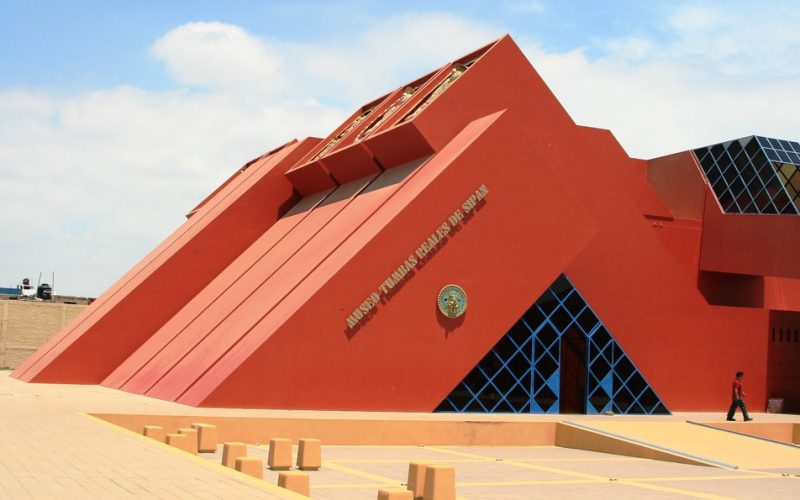
Arrival in Chiclayo, Tumbesian Birding & the Lord of Sipán
We begin our Northern Peru Birding and Culture Tour with an early morning flight from Lima to the coastal city of Chiclayo. Upon arrival, we head directly to Puerto Eten, a hotspot for coastal and desert birding. Here, we’ll scan for specialties like Gray Gull, Belcher’s Gull, Kelp Gull, Coastal Miner, Fasciated Wren, Amazilia Hummingbird, Many-colored Rush-Tyrant, Peruvian Meadowlark, and Tawny-throated Dotterel.
From there, we move inland to Rafán, a dry scrub area where we target some key Tumbesian endemics including the spectacular Peruvian Plantcutter, Tumbes Tyrannulet, Scarlet-backed Woodpecker, Cinereous Finch, and more.
After a delicious traditional lunch in Chiclayo, we shift gears into cultural exploration with a visit to the renowned Señor de Sipán Museum in Lambayeque. This world-class museum displays the dazzling artifacts and burial treasures of the Moche civilization, including the iconic tomb of the Lord of Sipán—one of the most important archaeological discoveries in the Americas.
🛏️ Night in Túcume, surrounded by pyramids and dry forest.
Bosque de Pómac Birding & Túcume Archaeological Heritage
We start the day with light birding around our lodge in Túcume, followed by a full morning exploring the trails of Bosque de Pómac, one of the last remaining dry forest ecosystems in Northern Peru. This reserve is home to an impressive collection of Tumbesian endemics and dry forest specialists such as:
Pacific Parrotlet, Streak-headed Woodcreeper, Necklaced Spinetail, Peruvian Plantcutter, Rufous Flycatcher, Tumbes Swallow, Superciliated Wren, Peruvian Thick-knee, Tumbes Pewee, Tumbes Chat-Tyrant, and the elusive Peruvian Pygmy Owl. With a bit of luck and silence, we may also encounter the Sechura Fox, a rare and shy mammal endemic to the region.
After a morning full of sightings, we’ll enjoy a well-earned break with either a picnic in the forest or a return to Túcume for lunch at a local restaurant.
In the afternoon, we dive into the cultural riches of Túcume with a visit to the Túcume Museum, located near the impressive Túcume archaeological complex—home to more than 20 adobe pyramids from the Lambayeque culture. This museum provides context and insight into the people who built these monumental structures, enhancing our journey through Peru’s historical timeline.
🛏️ Night in Túcume, where the past and present meet in the heart of the dry forest.
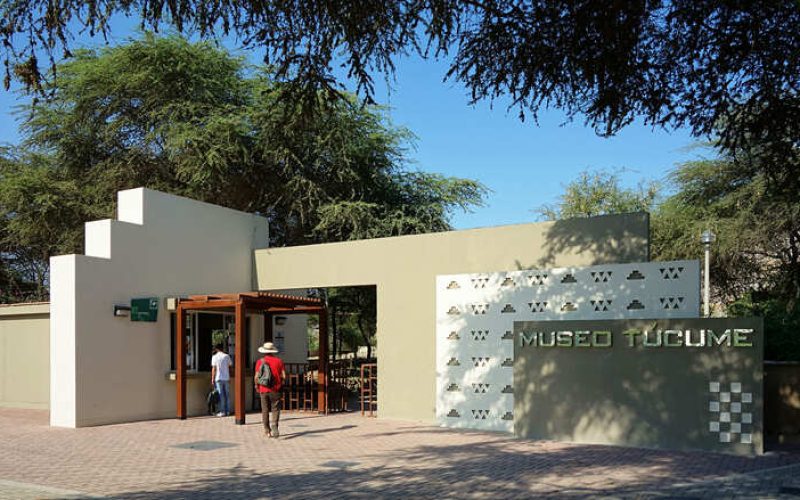
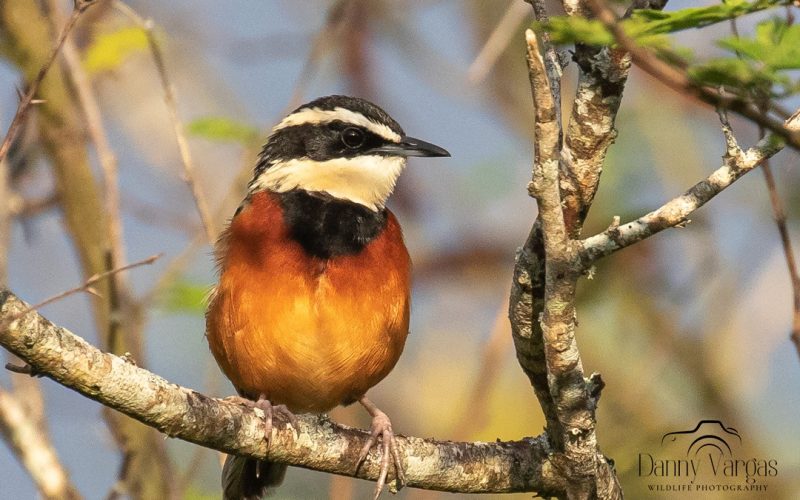
Abra Porculla Birding & Dry Marañón Valley Endemics
After breakfast, we head into the mountains for a full day of exceptional birding. Our first stop is the iconic Abra Porculla, a mid-elevation pass in the Western Andes and the lowest point along the continental divide in Peru. This unique transition zone between Pacific dry forest and Andean ecosystems harbors a rich mix of species, including: Tschudi’s Nightjar, Peruvian Sheartail, Purple-collared Woodstar, Tumbes Pewee, White-winged Brushfinch, Gray-browed Brushfinch, Bay-crowned Brushfinch, Black-crested Warbler, Black-cowled Saltator, Elegant Crescentchest, Porculla Hermit, and Mouse-colored Tyrannulet.
After a thrilling morning in this endemic-rich zone, we enjoy a picnic lunch surrounded by dramatic mountain landscapes.
In the afternoon, we descend toward Jaén, stopping to bird the Dry Marañón Valley—a region known for its high degree of endemism and arid beauty. Target species here include: Little Inca-Finch, Striped Cuckoo, Chapman’s Antshrike, Northern Slaty Antshrike, Rufous-fronted Thornbird, and Marañón Tyrannulet—all adapted to the dry scrub and unique topography of this isolated valley.
We arrive in Jaén by late afternoon, where you’ll enjoy dinner and a comfortable overnight stay.
🛏️ Night in Jaén—gateway to the Marañón and Utcubamba Valleys.
Marvelous Spatuletail & Endemics of the Marañón Valley
After breakfast, we venture into the forested slopes of the Marañón Valley, one of Peru’s most important centers of endemism. This dry inter-Andean ecosystem harbors a number of localized species, many with extremely limited ranges. Key targets this morning include: Peruvian Pigeon, Ecuadorian Ground-Dove, Tropical Gnatcatcher, Purple-throated Euphonia, Red-crested Finch, Tataupa Tinamou, Brown-crested Flycatcher, Spot-throated Hummingbird, Peruvian Screech-Owl, Marañón Crescentchest, Marañón Spinetail, Fulvous-faced Scrub-Tyrant, and Yellow-tailed Oriole, among others.
Following a productive morning of birding, we return to Jaén to pack and begin our scenic drive toward the lush Utcubamba Valley and the tranquil village of Cocachimba, nestled beneath towering green cliffs.
In the late afternoon, we’ll explore the area around Cocachimba, where birding highlights include one of Peru’s most iconic species—the Marvelous Spatuletail. This stunning hummingbird is frequently seen foraging near local gardens. Other notable birds in this region include: Chestnut-breasted Coronet, Marañón Thrush, Speckle-chested Piculet, Lesser Violetear, Buff-bellied Tanager, Little Woodstar, Collared Inca, and the elusive Utcubamba Tapaculo.
With the Gocta Waterfall looming in the background, we conclude the day in one of northern Peru’s most picturesque cloud forest destinations.
🛏️ Night in Cocachimba – home of the Marvelous Spatuletail and gateway to Gocta Falls.
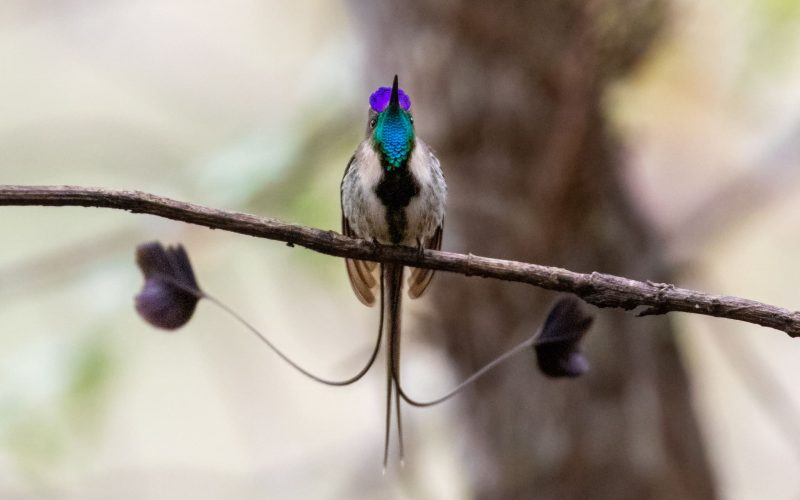
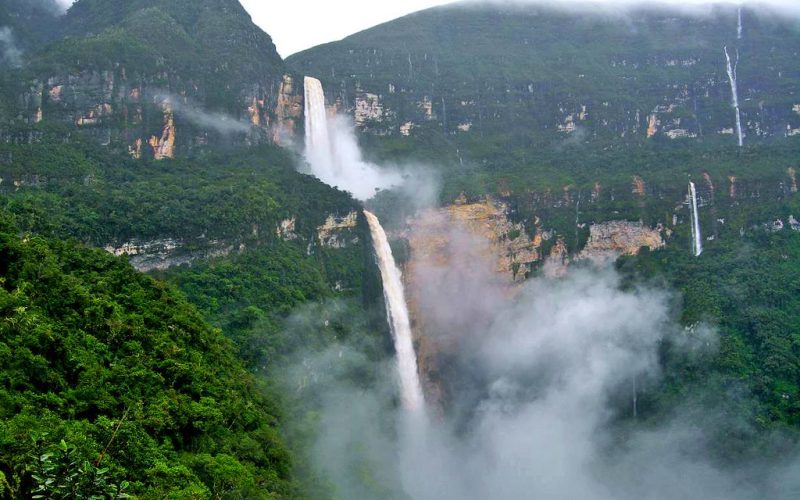
Gocta Waterfall Trek & Cloud Forest Birding in Cocachimba
This morning, we immerse ourselves in the lush cloud forest surrounding Cocachimba, a picturesque village perched on the edge of one of the tallest waterfalls in the world. After breakfast, we begin a scenic trek to Gocta Waterfall, a towering cascade that drops over 700 meters (2,300 feet) through the dense green canopy.
As we hike through this breathtaking forest, keep an eye out for one of the region’s most iconic birds—the Andean Cock-of-the-rock, often seen displaying along mossy cliffs and ravines. This area is also rich in mid-elevation specialties, and our bird list may include: Inca Jay, Bronzy Inca, Andean Emerald, Southern Emerald-Toucanet, White-crowned Tapaculo, Slaty-capped Flycatcher, Flavescent Flycatcher, Speckle-breasted Wren, Metallic-green Tanager, Chestnut-crowned Antpitta, and more.
After reaching the falls and enjoying the natural beauty and birdlife of this remarkable site, we return to Cocachimba for a well-deserved lunch and rest.
In the late afternoon, we may pay one last visit to a local feeder in hopes of catching another glimpse of the dazzling Marvelous Spatuletail, one of Peru’s most coveted endemic hummingbirds.
🛏️ Night in Cocachimba, surrounded by the sounds of the cloud forest and the serene ambiance of the Andean wilderness.
Kuelap Fortress – A Journey into the Heart of the Chachapoyas Civilization
After breakfast in Cocachimba, we embark on a cultural and scenic adventure to one of Northern Peru’s most iconic archaeological sites—the Kuelap Fortress. This massive stone citadel, perched on a high ridge overlooking the Utcubamba Valley, was once a stronghold of the mysterious Chachapoyas culture, known as the “Warriors of the Clouds.”
Our journey includes a scenic drive and a cable car ride offering panoramic views of the Andes Mountains and lush valleys below. Upon arrival at Kuelap, we step into a world of ancient stone walls, intricate carvings, and circular dwellings surrounded by orchids and bromeliads clinging to the misty walls.
Your expert guide will lead you through this monumental site, unraveling its enigmatic history and the legacy of the Chachapoyas people who once thrived in this cloud forest stronghold.
After exploring, we return to the Utcubamba Valley for a delicious local lunch surrounded by beautiful Andean scenery.
Later in the afternoon, we continue our drive through the valley to reach the peaceful town of Leymebamba, nestled in the highlands and known for its cultural richness and archaeological significance.
Night in Leymebamba

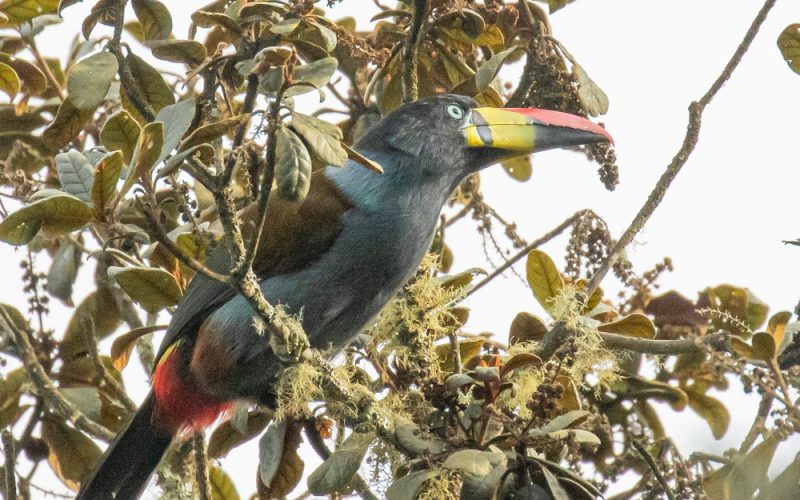
Birding in Atuen Valley & Chachapoyas Mummies at Leymebamba Museum
We begin the day immersed in high Andean birding as we explore the Atuen Valley near Leymebamba. This lush valley, cloaked in cloud forest, is home to some of Northern Peru’s most sought-after mountain species. Among the highlights are: Chestnut-crowned Antpitta, Gray-breasted Mountain-Toucan, Scarlet-bellied Mountain-Tanager, Large-footed Tapaculo, Rainbow Starfrontlet, Golden-headed Quetzal, Maroon-belted Chat-Tyrant, Masked Trogon, Black-necked Woodpecker, Puna Ibis, and others.
The combination of steep terrain, bamboo stands, and moss-draped trees makes this a productive and scenic birding destination for both hardcore listers and bird photography enthusiasts.
After a rewarding morning in the field, we return to Leymebamba for lunch.
In the afternoon, we delve into the region’s rich archaeological past with a visit to the Leymebamba Museum. Here, more than 200 well-preserved Chachapoyas mummies and a treasure trove of ceramics, textiles, and funerary offerings tell the story of one of Peru’s most enigmatic pre-Inca cultures. It’s a fascinating cultural counterpart to the morning’s natural immersion.
We close the day with time to relax and reflect on the unique blend of nature and history this highland region offers.
🛏️ Night in Leymebamba
High-Elevation Birding at Abra Barro Negro & Inca-Finches of Balsas
We begin our day early in Leymebamba, setting out after breakfast for a spectacular day of high Andean birding at Abra Barro Negro, one of the best sites in northern Peru for elevation-specialized species.
This dramatic mountain pass offers excellent opportunities to spot some of Peru’s most localized and range-restricted birds, including:
Many-striped Canastero, Grass Wren, Yellow-breasted Brushfinch, Purple-backed Thornbill, Sapphire-vented Puffleg, Yungas Pygmy-Owl, White-chinned Thistletail, Sword-billed Hummingbird, Paramo Pipit, and the endemic Chachapoyas Antpitta and Leymebamba Antpitta—both highly prized targets for listers and endemism enthusiasts.
We’ll stop for a scenic picnic lunch surrounded by panoramic mountain views, before descending to the dry inter-Andean valley of Balsas, where the birding continues in a completely different habitat.
This arid region is home to some of Northern Peru’s signature dry-forest endemics, including: Buff-bridled Inca-Finch (E), Gray-winged Inca-Finch (E), Yellow-faced Parrotlet, and Black-necked Woodpecker—all excellent highlights in one of the most species-diverse gradients in South America.
As the sun sets over the valleys, we’ll arrive in the tranquil Andean town of Celendín, where a hearty meal and restful night await.
🛏️ Night in Celendín
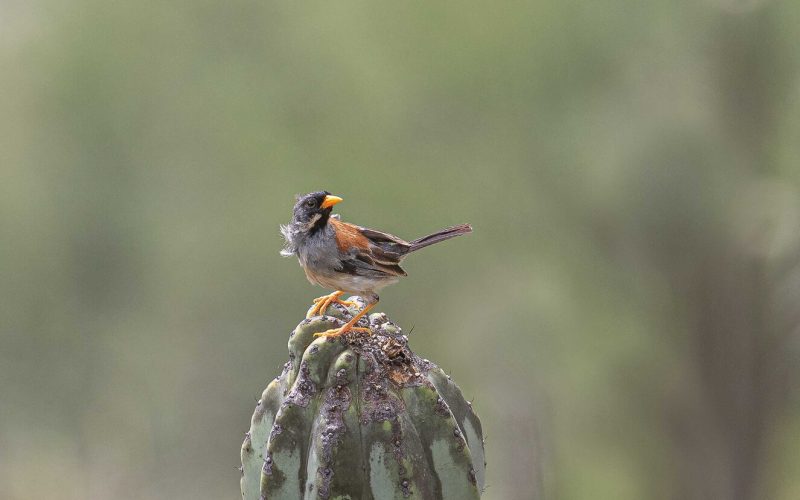
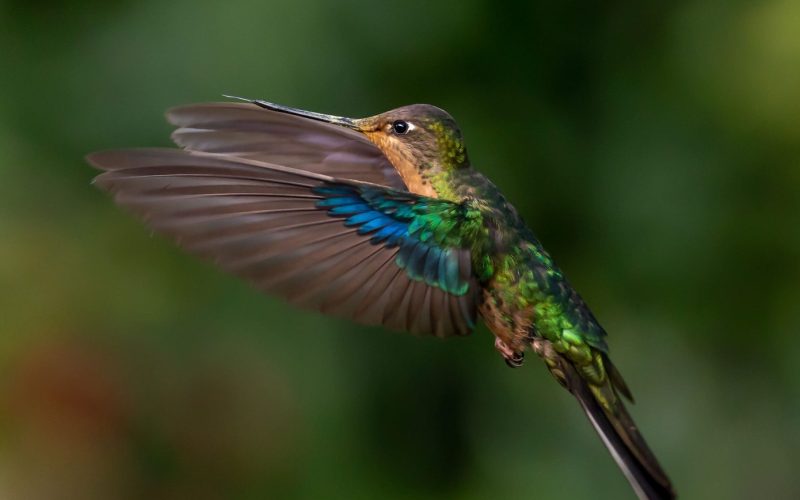
Cruz Conga & Sangal – Endemics on the Road to Cajamarca
We start our day in Celendín with another exciting chapter of high-altitude birding in Northern Peru. Today, our route takes us through the scenic birding hotspots of Cruz Conga and Sangal, as we make our way toward the historic city of Cajamarca.
These mid- to high-elevation cloud forests and scrubby hillsides are teeming with range-restricted species and striking Andean endemics. With binoculars ready, we’ll be on the lookout for: Gray-bellied Comet (E), Cajamarca Antpitta (E), Plain-tailed Warbling-Finch (E), Rusty-crowned Tit-Spinetail (E), Great Sapphirewing, Slender-billed Miner, Peruvian Sierra-Finch, Black-crested Tit-Tyrant, Black-chested Buzzard-Eagle, Rufous-eared Brushfinch (E), and the majestic Giant Hummingbird.
The winding roads and breathtaking landscapes along the way make this not just a birding route—but a truly immersive travel experience through some of Peru’s most underexplored birding regions.
As the afternoon unfolds, we descend into Cajamarca, a colonial gem steeped in history and surrounded by fertile Andean valleys. We’ll settle in for the night and prepare for a cultural exploration of this iconic Peruvian city.
🛏️ Night in Cajamarca
Colonial Heritage and Inca Legacy – Cajamarca City Tour & Departure
We’ll spend the morning exploring the cultural and historical treasures of Cajamarca, one of Peru’s most charming colonial cities and the stage for one of the most pivotal events in Inca history.
Our Cajamarca city tour begins at the iconic Plaza de Armas, framed by beautiful colonial architecture and traditional balconies. From here, we’ll visit the grand Cathedral of Cajamarca, a 17th-century architectural gem known for its ornate Baroque façade and rich religious artwork.
Next, we’ll head to Santa Apolonia Hill, where panoramic views of the city unfold before us. This site also holds the Cuarto del Rescate (Ransom Room)—the very place where the Inca emperor Atahualpa was held by the Spanish conquistador Francisco Pizarro, marking a turning point in the Spanish conquest of the Andes.
Following this cultural immersion, we’ll enjoy a final lunch at one of Cajamarca’s traditional restaurants, savoring flavors from Peru’s northern highlands.
In the afternoon, it’s time to say farewell as we transfer to the airport for your departure.
✈️ End of Services
